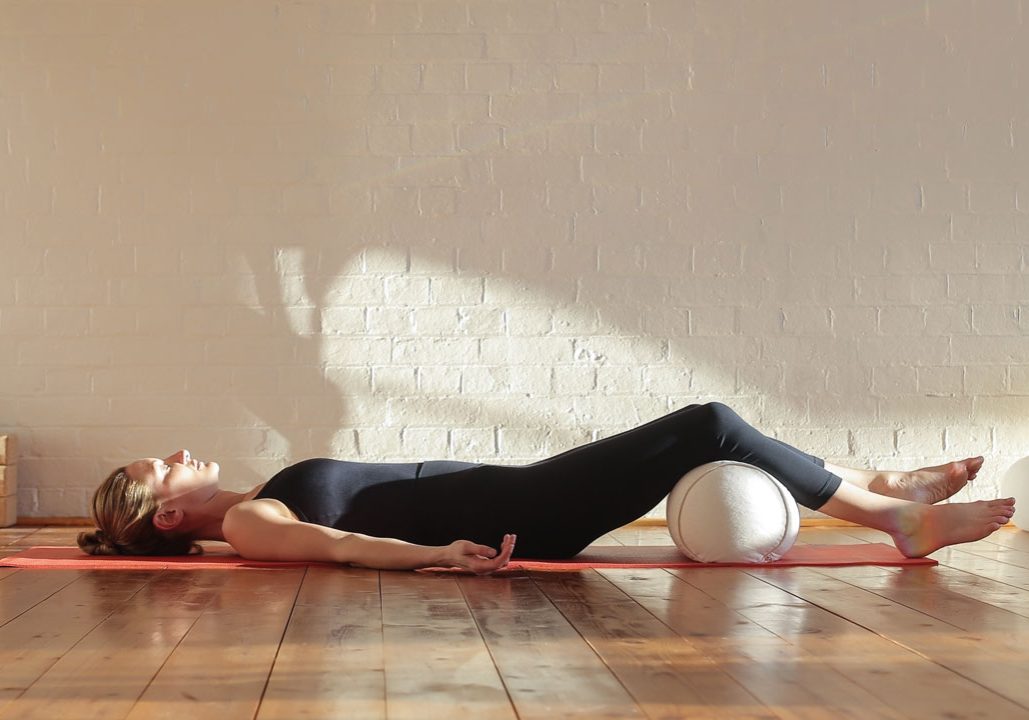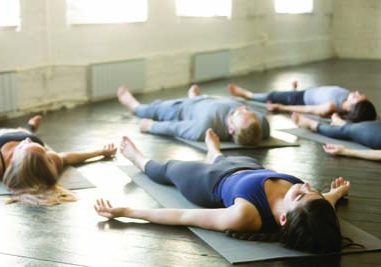
The Power of Savasana
How the blissful practice of Savasana might just transform your life. By Paula Hines
Savasana is the foundation of restorative yoga. In restorative yoga, props are used to provide support and comfort for the body, facilitating deep relaxation and rest. Often described as the easiest pose to do, but the most difficult to master, if you struggle with Savasana you may find that the use of props transforms your experience. If you don’t have yoga bolsters or blocks this needn’t be a barrier. Your props can be pillows, cushions, blankets and other items you may have around you.
In 2014 I embarked on my own daily restorative savasana practice – The 365 Savasana Project (which I wrote about at the time in this very magazine) – 20 minutes a day each day for a whole year. That’s not to say that you have to do the same. If the most you can manage on any given day is two to three minutes you will still benefit from pausing and resting for this time. However, if you can manage 20 minutes, here is why it can be so beneficial for deep relaxation and rejuvenation: Physiological relaxation: when we move from a sympathetic nervous system state to a parasympathetic nervous system state. The weight of the physical body completely lets go into the props or surface supporting it. Although we’re all different, for the average person it can take around 15 minutes to make that shift. Pratyahara, which translates as ‘withdrawal of the senses’, the fifth of Patanjali’s eight limbs of yoga. This is a state where you’re not disturbed. It is a stage between being awake and asleep.
You may be aware of sounds around you, but they don’t disturb you. A deeply restorative Savasana tends to be around 20 minutes to allow plenty of time for these shifts to occur. What I have discovered when I practice Savasana for 20 minutes, and have also heard from the countless testimonials of students, is that in the beginning your mind will wander or race (thinking about dinner or your to-do list is common). At first, the physical body is a little fidgety, but then at some point it’s as though the weight of the body sinks down and the thinking mind goes somewhere else.
However, it’s not until the end of the practice that it’s apparent the mind has been elsewhere and, at the same time, the physical body feels rejuvenated and muscle tension is eased. It’s akin to being asleep, but not the same; it’s a state that is incredibly difficult to describe and can only be experienced.
The five layers
For a little more understanding on the Pratyahara state and what you might experience, not only in a restorative Savasana, but also during a restorative pose or sequence when you’re engaging in a practice of 20 minutes or more, it can be helpful to have an awareness that from a yoga perspective we are more than our physical body. Here’s a short overview of the koshas – the five layers or ‘sheaths’ that you may move through or between during a practice.
The Koshas
The physical body (annamaya kosha) is what you will initially be aware of in restorative yoga poses, particularly the parts of the body in contact with the surfaces they’re resting on, such as the floor or bed, pillows, blankets, cushions and so on.
The energy body (pranamaya kosha) is enhanced by breathing practices – ‘prana’ translates as ‘life force’ and breath is one of the vehicles for transporting prana through the body.
The mind/emotion body (manomaya kosha) incorporates the whole nervous system, including the brain. Sensory withdrawal (the ‘Pratyahara’ state mentioned earlier) is rejuvenating for this layer. This place of sensory withdrawal can also be reached via yoga nidra. Deep rest and deep sleep regenerates the mind/ emotion body.
The wisdom body (vijnanamaya kosha) represents our discernment. Stillness – restorative yoga in this instance, but also yoga nidra and sitting meditation – strengthens our ability to connect to our inner wisdom and have clarity of judgement. Think of times in your life when you have made decisions in a tired, overwhelmed or highly stressed state. Would you have made a different decision if you had felt rested and had greater clarity of mind? By tending to the wisdom body, another by-product in day-to-day life can be the ability to pause before reacting when faced with difficult situations.
The bliss body (anandamaya kosha) is the fifth and final layer. ‘Ananda’ translates as ‘bliss’ or ‘ecstasy’. It is our true nature, our essence. It is coming home to yourself. There is no guarantee that you will experience moving through the layers during your practice to reach the bliss body. If you do, it is usually not until you end your practice that you feel aware that you have ‘been somewhere’. It is not something that you can force or ‘will’ to happen.
The practice of restorative yoga is simple, yet it can be incredibly profound. To this day, it continues to teach me. All of the occasions when I think I have no time to practice, by lying down on the floor with my props I find that afterwards I am more at ease and clear-headed, plus if I do have important tasks, I am more efficient in completing them. In other words, making the time to practice Savasana or any restorative pose, even if it’s not for as long as 20 minutes, gives rather than takes time.

SOME TIPS FOR PRACTICE:
Once you have decided where you will practice, before you lie down, put a cushion in place to support your head and neck. Carefully lie down on your back and place support (e.g. pillows) underneath the back of your knees, before extending your legs out straight over them. Having sufficient support under the knees is kinder on the lower back and particularly important to consider if you experience back pain or have concerns around your lower back. If your heels don’t touch the floor, take a rolled up soft towel (or similar) and place it under your ankles.
Ensure your head and neck feel comfortable. If you notice that your chin is pointing upward then bring your chin slightly inward towards your chest so that the back of your neck is lengthened.
Set a timer for your allotted time. If you’re allowing twenty minutes, then it’s a good idea to set your timer now for twenty-two minutes to give yourself time to settle in.
Cover your body with a blanket or throw. Use an eye pillow or soft scarf to cover your eyes. Rest your arms by your sides with palms facing up.
Allow your hands to soften. You will notice that your fingers will naturally curl in towards your palms. If placing your arms by your sides doesn’t feel comfortable, try resting your palms down on your lower abdomen.
Before you completely settle into your supported restorative Savasana, allow around thirty to 60 seconds to see how you feel. Is there anything you can do to make yourself even ten per cent more comfortable? Make any adjustments you need to until you no longer have the desire to move.




